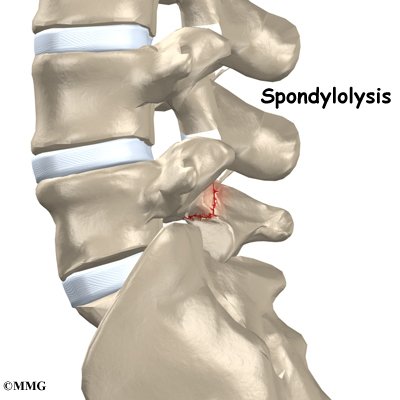LOWER BACK STRESS FRACTURE (SPONDYLOLYSIS)
Stress fractures of the lower back are given the term Spondylolysis or a Pars Defect, and Physiotherapists are commonly one of the first health professionals to suspect these in the adolescent population.
Spondylolysis cases are actually fairly common, with a prevalence of about 1 in 20 people, and interestingly, not every case is Symptomatic (painful).
SPONDYLOLYSIS SYMPTOMS
The most common symptom of the stress fracture is localised lower back pain, usually around the L5 region.
The main movement that will aggravate the pain in Spondylolysis is typically extension movements (bending backwards). Pain is relieved with rest and stopping physical activity.
Sports such as gymnastics, tennis, football and cricket tend to have a higher prevalence of Stress Fractures as there is a lot of repetitive extension type movements involved in the sport.
SPONDYLOLYSIS EARLY DETECTION AND DIAGNOSIS
As this condition is fairly common in youths, when they present into the Physiotherapists or Doctors clinic with back pain, we may begin to suspect a Spondylolysis especially if they are very physically active.
A recent research paper by Sugiura S et al (2022) has determined that a fairly reliable way for Physiotherapists to suspect early stage spondylolysis is by performing a lateral flexion test.
If it is reproductive of the client's pain, then they should be referred onward to the Orthopaedic Specialist for further imaging to confirm or rule out a stress fracture (MRI/CT scan).
If you or your child (<18year old) is experiencing lower back pain with extension movements/sports, it’s best to get it assessed by a professional experienced with differentiating general low back pain from a specific pathology like Spondylolysis.
Early detection and diagnosis will allow for prompt treatment, expediting recovery and reducing risk of further complications.
SPONDYLOLYSIS TREATMENT AND MANAGEMENT
Fortunately, most spondylolysis cases will be managed conservatively (non surgically).
As a general rule, a period of relative rest will be enforced (>6 weeks), and immediate commencement of Physiotherapy should begin.
Physiotherapy management will focus initially on pain relief techniques, and will gradually incorporate core stability and whole body strengthening work.
The intent of the exercise rehabilitation is to train the body to control its movement into ranges of extension, without overloading the spine.
SPONDYLOLYSIS COMPLICATIONS
In the rare, severe case that the stress fracture does not improve radiologically and clinically, a Spondylolisthesis may occur.
A Spondylolisthesis is when the stress fracture doesn’t heal and the lumbar vertebrae above ‘slips forward’ on the bottom, as the fracture is now unable to maintain proper spinal alignment.
This may result in further pain, and even nerve pain down the leg.
An escalation of care may be required, using either a lumbar brace, or even surgery to fuse the slipped joint into place. This will all be considered if proper Physiotherapy management fails.
SPONDYLOLYSIS PROGNOSIS
With careful treatment and guidance, most will recover from the stress fracture with time and curated rehabilitation programs designed by an experienced Physiotherapist.
At Physiologic, we’re experienced in the management of Spinal conditions like Spondylolysis, getting our athletes out of pain quickly and rehabilitating them back to their chosen sport. Contact us to see how we can help with the recovery journey back to your competitive best!
ABOUT THE AUTHOR
Ryan Tan is our Clinical Director and Physiotherapist here at Physiologic Hong Kong. He’s had over 10 years of experience as a sports and spinal Physiotherapist. He has acquired his Certificate of Spinal Manual Therapy (COSMT), an intensive course focussing purely on treating spinal conditions. He also has extensive experience working in Complex Pain Clinics in London, treating complex spinal conditions that have been through Spinal Surgeries and procedures. Ryan now works closely with Orthopaedic Spinal Specialists to provide collaborative care and expert Physiotherapy treatment to those suffering from back pain. If you have a complex Spinal injury that hasn’t been able to be resolved, contact us for a no obligation assessment!




